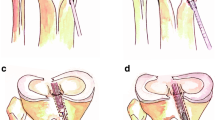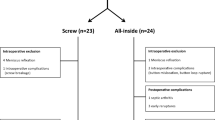Abstract
Background
The purpose of this study was to investigate whether cortical non-contact or delayed contact of an adjustable-loop button for femoral fixation could affect knee stability following anterior cruciate ligament (ACL) reconstruction.
Methods
Eighty subjects who underwent single-bundle ACL reconstruction using an adjustable-loop femoral cortical button were retrospectively reviewed regarding patient demographics, graft size, combined surgery, and postoperative 2-year results of knee stability, functional scores, and radiographic tunnel widening. We compared the contact and the non-contact groups determined by position of the button observed in immediate postoperative radiographs. According to 2-year postoperative radiographs, the non-contact group was further divided into two subgroups (delayed contact and persisting non-contact subgroups) and results were compared.
Results
The contact group had 46 patients and the non-contact group had 34 patients. The average gap distance in the non-contact group was 1.9 ± 0.6 (1.1–3.4) mm. There were no significant differences in KT-1000 arthrometric knee stability (p = .667) or Lysholm score (p = .198), or International Knee Documentation Committee (IKDC) score (p = .091) between the two groups. No significant differences in tunnel widening were found at femoral and tibial tunnels on anteroposterior and lateral radiographs (p > .1, all tunnels). In addition, delayed contact subgroup and persisting non-contact subgroup showed similar radiographic and clinical outcomes.
Conclusion
Surgeons should strive to obtain cortical contact of the adjustable-loop femoral button. Nevertheless, cortical non-contact with less than 3 mm of gap distance did not affect knee stability, radiographic outcomes, or clinical outcomes.
Level of evidence
Level III, retrospective comparative study.




Similar content being viewed by others
References
Simonian PT, Behr CT, Stechschulte DJ Jr, Wickiewicz TL, Warren RF (1998) Potential pitfall of the EndoButton. Arthroscopy 14(1):66–69
Kawaguchi K, Kuribayashi S, Nakayama S, Nakazato K, Fukubayashi T, Okinaga S (2016) Lateral knee pain after outside-in anatomic double-bundle anterior cruciate ligament reconstruction using the TightRope RT. Knee Surg Relat Res 28(1):83–87. https://doi.org/10.5792/ksrr.2016.28.1.83
Taketomi S, Inui H, Hirota J, Nakamura K, Sanada T, Masuda H, Tanaka S, Nakagawa T (2013) Iliotibial band irritation caused by the EndoButton after anatomic double-bundle anterior cruciate ligament reconstruction: report of two cases. Knee 20(4):291–294. https://doi.org/10.1016/j.knee.2013.03.013
Nag HL, Gupta H (2012) Seating of TightRope RT button under direct arthroscopic visualization in anterior cruciate ligament reconstruction to prevent potential complications. Arthrosc Tech 1(1):e83–e85. https://doi.org/10.1016/j.eats.2012.03.003
Ekdahl M, Wang JH, Ronga M, Fu FH (2008) Graft healing in anterior cruciate ligament reconstruction. Knee Surg Sports Traumatol Arthrosc 16(10):935–947. https://doi.org/10.1007/s00167-008-0584-0
Kousa P, Jarvinen TL, Vihavainen M, Kannus P, Jarvinen M (2003) The fixation strength of six hamstring tendon graft fixation devices in anterior cruciate ligament reconstruction. Part I: femoral site. Am J Sports Med 31(2):174–181. https://doi.org/10.1177/03635465030310020401
Shelton WR, Fagan BC (2011) Autografts commonly used in anterior cruciate ligament reconstruction. J Am Acad Orthop Surg 19(5):259–264
Fu FH, Bennett CH, Lattermann C, Ma CB (1999) Current trends in anterior cruciate ligament reconstruction. Part 1: biology and biomechanics of reconstruction. Am J Sports Med 27(6):821–830. https://doi.org/10.1177/03635465990270062501
Lubowitz JH, Ahmad CS, Anderson K (2011) All-inside anterior cruciate ligament graft-link technique: second-generation, no-incision anterior cruciate ligament reconstruction. Arthroscopy 27(5):717–727. https://doi.org/10.1016/j.arthro.2011.02.008
Harato K, Niki Y, Toyoda T, Kamata Y, Masumoto K, Otani T, Suda Y (2016) Self-flip technique of the TightRope RT button for soft-tissue anterior cruciate ligament reconstruction. Arthrosc Tech 5(2):e391–e395. https://doi.org/10.1016/j.eats.2016.01.022
Sonnery-Cottet B, Rezende FC, Martins Neto A, Fayard JM, Thaunat M, Kader DF (2014) Arthroscopically confirmed femoral button deployment. Arthrosc Tech 3(3):e309–e312. https://doi.org/10.1016/j.eats.2014.01.007
Mae T, Kuroda S, Matsumoto N, Yoneda M, Nakata K, Yoshikawa H, Shino K (2011) Migration of EndoButton after anatomic double-bundle anterior cruciate ligament reconstruction. Arthroscopy 27(11):1528–1535. https://doi.org/10.1016/j.arthro.2011.06.024
Kang SG, Lee YS (2017) Arthroscopic control for safe and secure seating of suspensory devices for femoral fixation in anterior cruciate ligament reconstruction using three different techniques. Knee Surg Relat Res 29(1):33–38. https://doi.org/10.5792/ksrr.16.053
Landis JR, Koch GG (1977) The measurement of observer agreement for categorical data. Biometrics 33(1):159–174
Lysholm J, Gillquist J (1982) Evaluation of knee ligament surgery results with special emphasis on use of a scoring scale. Am J Sports Med 10(3):150–154. https://doi.org/10.1177/036354658201000306
Rossi MJ, Lubowitz JH, Guttmann D (2002) Development and validation of the International Knee Documentation Committee subjective knee form. Am J Sports Med 30(1):152. https://doi.org/10.1177/03635465020300011301
Boyle MJ, Vovos TJ, Walker CG, Stabile KJ, Roth JM, Garrett WE Jr (2015) Does adjustable-loop femoral cortical suspension loosen after anterior cruciate ligament reconstruction? A retrospective comparative study. Knee 22(4):304–308. https://doi.org/10.1016/j.knee.2015.04.016
Hoher J, Moller HD, Fu FH (1998) Bone tunnel enlargement after anterior cruciate ligament reconstruction: fact or fiction? Knee Surg Sports Traumatol Arthrosc 6(4):231–240. https://doi.org/10.1007/s001670050105
Simonian PT, Monson JT, Larson RV (2001) Biodegradable interference screw augmentation reduces tunnel expansion after ACL reconstruction. Am J Knee Surg 14(2):104–108
Takata Y, Nakase J, Oshima T, Shimozaki K, Asai K, Tsuchiya H (2018) No difference in the graft shift between a round and a rounded rectangular femoral tunnel for anterior cruciate ligament reconstruction: an experimental study. Arch Orthop Trauma Surg. https://doi.org/10.1007/s00402-018-2958-121
Webster KE, Feller JA, Hameister KA (2001) Bone tunnel enlargement following anterior cruciate ligament reconstruction: a randomised comparison of hamstring and patellar tendon grafts with 2-year follow-up. Knee Surg Sports Traumatol Arthrosc 9(2):86–91. https://doi.org/10.1007/s001670100191
Choi NH, Oh JS, Jung SH, Victoroff BN (2013) Correlation between endobutton loop length and tunnel widening after hamstring anterior cruciate ligament reconstruction. Am J Sports Med 41(1):101–106. https://doi.org/10.1177/0363546512466384
Choi NH, Yang BS, Victoroff BN (2017) Clinical and radiological outcomes after hamstring anterior cruciate ligament reconstructions: comparison between fixed-loop and adjustable-loop cortical suspension devices. Am J Sports Med 45(4):826–831. https://doi.org/10.1177/0363546516674183
Petit C, Millett PJ (2008) Arthroscopic removal of EndoButton after anterior cruciate ligament reconstruction: case report and surgical technique. Am J Orthop (Belle Mead, NJ) 37(12):618–620
Buoncristiani AM, Tjoumakaris FP, Starman JS, Ferretti M, Fu FH (2006) Anatomic double-bundle anterior cruciate ligament reconstruction. Arthroscopy 22(9):1000–1006. https://doi.org/10.1016/j.arthro.2006.06.005
Gabriel MT, Wong EK, Woo SL, Yagi M, Debski RE (2004) Distribution of in situ forces in the anterior cruciate ligament in response to rotatory loads. J Orthop Res 22(1):85–89. https://doi.org/10.1016/S0736-0266(03)00133-5
Sakane M, Fox RJ, Woo SL, Livesay GA, Li G, Fu FH (1997) In situ forces in the anterior cruciate ligament and its bundles in response to anterior tibial loads. J Orthop Res 15(2):285–293. https://doi.org/10.1002/jor.1100150219
Goradia VK, Rochat MC, Grana WA, Rohrer MD, Prasad HS (2000) Tendon-to-bone healing of a semitendinosus tendon autograft used for ACL reconstruction in a sheep model. Am J Knee Surg 13(3):143–151
Barrett JF, Keat N (2004) Artifacts in CT: recognition and avoidance. Radiographics 24(6):1679–1691. https://doi.org/10.1148/rg.246045065
Funding
No funding was received for this study.
Author information
Authors and Affiliations
Corresponding author
Ethics declarations
Conflict of interest
All authors of this study declare that there is no conflict of interest relevant to this study.
Ethical approval
This article does not contain any prospective studies with human participants or animals performed by any of the authors. IRB approval by IRB of Seoul St. Mary's Hospital, the Catholic University of Korea Study No.: KC17RESI0742.
Additional information
Publisher's Note
Springer Nature remains neutral with regard to jurisdictional claims in published maps and institutional affiliations.
Rights and permissions
About this article
Cite this article
Sohn, S., Koh, I.J., Kim, M.S. et al. Does non-contact or delayed contact of an adjustable-loop femoral button affect knee stability following anterior cruciate ligament reconstruction?. Arch Orthop Trauma Surg 139, 1407–1415 (2019). https://doi.org/10.1007/s00402-019-03213-8
Received:
Published:
Issue Date:
DOI: https://doi.org/10.1007/s00402-019-03213-8




